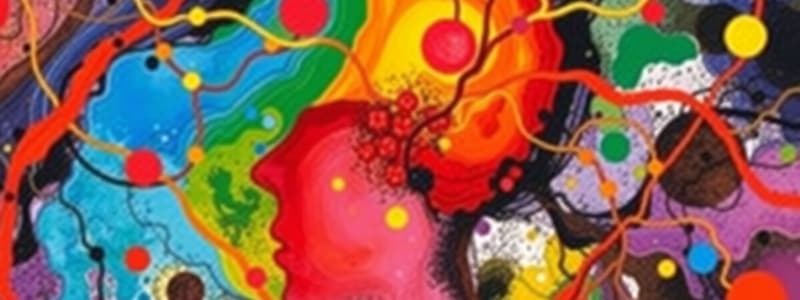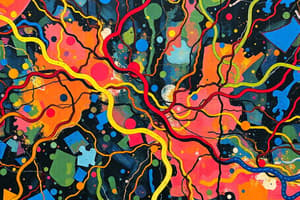Podcast
Questions and Answers
What is primarily associated with positive symptoms of schizophrenia?
What is primarily associated with positive symptoms of schizophrenia?
- Reduced dopamine in the mesocortical pathway
- Normal dopamine levels in the tuberoinfundibular pathway
- Excess dopamine in the mesolimbic pathway (correct)
- Reduced dopamine in the nigrostriatal pathway
Which pathway is primarily involved in cognitive and negative symptoms of schizophrenia?
Which pathway is primarily involved in cognitive and negative symptoms of schizophrenia?
- Nigrostriatal pathway
- Tuberoinfundibular pathway
- Mesolimbic pathway
- Mesocortical pathway (correct)
What is a potential side effect of antipsychotic medications related to the nigrostriatal pathway?
What is a potential side effect of antipsychotic medications related to the nigrostriatal pathway?
- Cognitive deficits
- Flat affect
- Hallucinations
- Tardive dyskinesia (correct)
What role does the mesolimbic pathway play in psychosis?
What role does the mesolimbic pathway play in psychosis?
Which symptom is specifically linked to reduced dopamine in the mesocortical pathway?
Which symptom is specifically linked to reduced dopamine in the mesocortical pathway?
What condition can result from excess dopamine activity at D2 receptors?
What condition can result from excess dopamine activity at D2 receptors?
Which pathway is connected to the substantia nigra and is linked to motor control?
Which pathway is connected to the substantia nigra and is linked to motor control?
Which condition is associated with hyperprolactinemia as a side effect of some antipsychotics?
Which condition is associated with hyperprolactinemia as a side effect of some antipsychotics?
What can result from the disruption of the tuberoinfundibular pathway due to antipsychotic use?
What can result from the disruption of the tuberoinfundibular pathway due to antipsychotic use?
Which of the following symptoms is classified as extrapyramidal symptoms (EPS) due to antipsychotics?
Which of the following symptoms is classified as extrapyramidal symptoms (EPS) due to antipsychotics?
In the context of psychosis, which statement is accurate regarding hallucinations?
In the context of psychosis, which statement is accurate regarding hallucinations?
What type of hallucination is most likely indicative of an organic problem?
What type of hallucination is most likely indicative of an organic problem?
Which symptom is a common type of fixed false belief in psychosis?
Which symptom is a common type of fixed false belief in psychosis?
What differentiates newer antipsychotics from older ones in terms of their action?
What differentiates newer antipsychotics from older ones in terms of their action?
What can be described as restlessness and an inability to sit still, commonly associated with antipsychotic treatment?
What can be described as restlessness and an inability to sit still, commonly associated with antipsychotic treatment?
What is the primary goal of antipsychotic medications?
What is the primary goal of antipsychotic medications?
What is a characteristic of depersonalization in Depersonalization/Derealization Disorder?
What is a characteristic of depersonalization in Depersonalization/Derealization Disorder?
Which type of dissociative amnesia involves a total loss of all memory from a certain time to the present?
Which type of dissociative amnesia involves a total loss of all memory from a certain time to the present?
What is a common trigger for identity switching in Dissociative Identity Disorder (DID)?
What is a common trigger for identity switching in Dissociative Identity Disorder (DID)?
Which of the following is NOT considered a cause of olfactory hallucinations?
Which of the following is NOT considered a cause of olfactory hallucinations?
In which dissociative disorder might an individual suddenly travel away from home with amnesia for their identity?
In which dissociative disorder might an individual suddenly travel away from home with amnesia for their identity?
What is a defining characteristic of schizophrenia?
What is a defining characteristic of schizophrenia?
Which condition is characterized by psychotic symptoms lasting less than one month?
Which condition is characterized by psychotic symptoms lasting less than one month?
What distinguishes Somatic Symptom Disorder from other medical conditions?
What distinguishes Somatic Symptom Disorder from other medical conditions?
What is a potential consequence of prolonged continuous and generalized amnesia?
What is a potential consequence of prolonged continuous and generalized amnesia?
What is a likely cause of tactile hallucinations?
What is a likely cause of tactile hallucinations?
Which of the following disorders presents with persistent delusions but lacks other psychotic symptoms?
Which of the following disorders presents with persistent delusions but lacks other psychotic symptoms?
Which of the following is NOT a characteristic of Dissociative Identity Disorder?
Which of the following is NOT a characteristic of Dissociative Identity Disorder?
Which symptom commonly leads to extensive medical evaluations in Somatic Symptom Disorder?
Which symptom commonly leads to extensive medical evaluations in Somatic Symptom Disorder?
What is a key factor in the development of psychosis related to schizophrenia?
What is a key factor in the development of psychosis related to schizophrenia?
Normal dissociation can occur in which of the following situations?
Normal dissociation can occur in which of the following situations?
What is a hallmark feature of dissociative disorders?
What is a hallmark feature of dissociative disorders?
Which disorder involves altered voluntary motor or sensory function without a neurological cause?
Which disorder involves altered voluntary motor or sensory function without a neurological cause?
What is a common characteristic of Illness Anxiety Disorder?
What is a common characteristic of Illness Anxiety Disorder?
What differentiates Factitious Disorder from Malingering?
What differentiates Factitious Disorder from Malingering?
In which disorder is the afflicted person more likely to seek unnecessary medical procedures?
In which disorder is the afflicted person more likely to seek unnecessary medical procedures?
Which statement correctly identifies a characteristic of Malingering?
Which statement correctly identifies a characteristic of Malingering?
What is a key feature of Factitious Disorder Imposed on Another?
What is a key feature of Factitious Disorder Imposed on Another?
Which age group is commonly affected by Illness Anxiety Disorder?
Which age group is commonly affected by Illness Anxiety Disorder?
What is the typical outcome of Factitious Disorder Imposed on Another in terms of potential harm?
What is the typical outcome of Factitious Disorder Imposed on Another in terms of potential harm?
Flashcards are hidden until you start studying
Study Notes
Introduction to Psychosis
- Psychosis: Altered perception of reality involving hallucinations and delusions
- Defining features: Positive symptoms, negative symptoms, and functional impairment
- Schizophrenia is the most common example, but other psychotic disorders exist
Dopamine and Psychosis
- Excess dopamine binding at D2 receptors in the mesolimbic pathway is associated with psychosis
- Psychosis is a symptom, not a diagnosis
- Schizophrenia: a specific psychotic disorder with diagnostic criteria
Dopamine Pathways in Schizophrenia
- Four dopamine pathways implicated in schizophrenia and its treatment:
- Mesolimbic pathway: Involved in positive symptoms of schizophrenia
- Mesocortical pathway: Involved in negative and cognitive symptoms of schizophrenia
- Nigrostriatal pathway: Involved in extrapyramidal symptoms (side effect of medication)
- Tuberoinfundibular pathway: Involved in hyperprolactinemia (side effect of medication)
Mesolimbic Pathway
- Connects the ventral tegmental area (VTA) to the nucleus accumbens (reward center)
- Implicated in motivation, pleasure, and reward
- Excess dopamine leads to positive symptoms of schizophrenia and heightened motivation
Mesocortical Pathway
- Connects the VTA to the prefrontal cortex (PFC)
- Reduced dopamine in this pathway leads to negative symptoms of schizophrenia
- Negative symptoms can impact long-term outcomes and are often worsened by antipsychotics
Nigrostriatal Pathway
- Connects the substantia nigra to the striatum (motor control)
- Antipsychotics can disrupt this pathway, leading to extrapyramidal symptoms and movement disorders
Tuberoinfundibular Pathway
- Connects the hypothalamus to the pituitary gland (prolactin production)
- Antipsychotics can disrupt this pathway, leading to hyperprolactinemia, galactorrhea, and menstrual irregularities
Antipsychotic Medications
- Aim to control dopamine activity in the mesolimbic pathway while minimizing effects on other pathways
- Newer antipsychotics are generally more effective at achieving this balance
Differentiating Among Psychoses
- Essential to characterize the specific type of psychosis for appropriate treatment
- Hallucinations: Sensory perceptions without external stimuli
- Auditory hallucinations: Most common in psychotic disorders
- Visual hallucinations: Can be associated with psychotic disorders or organic conditions
- Tactile, olfactory, gustatory hallucinations: More likely to have organic causes
- Delusions: Fixed, false beliefs despite evidence to the contrary
- Various types: Grandiosity, persecution, infidelity, religion, nihilistic, somatic, guilt
Psychotic Disorders
- Schizophrenia: Chronic psychotic disorder with positive and negative symptoms and functional impairment
- Schizoaffective Disorder: Meets criteria for both schizophrenia and a mood disorder
- Schizophreniform Disorder: Symptoms of schizophrenia for less than 6 months
- Brief Psychotic Disorder: Psychotic symptoms lasting less than one month
- Delusional Disorder: Persistent delusions without other psychotic symptoms
- Substance-Induced Psychosis: Psychosis caused by substance use
- Psychotic Disorder Due to a Medical Condition: Psychosis caused by an underlying medical condition
- Paraphrenia: Chronic psychotic disorder similar to schizophrenia but with better-preserved affect and functioning
Key Takeaways
- Excess dopamine in the mesolimbic pathway is a major factor in psychosis.
- Different dopamine pathways play a role in schizophrenia and its treatment.
- Antipsychotics are used to control psychosis while minimizing side effects.
- Distinguishing among different types of psychotic disorders is crucial for appropriate treatment.
Introduction to Dissociation
- Dissociation: Disconnection between thoughts, memories, feelings, or sense of self
- Normal dissociation is common (daydreaming, highway hypnosis)
- Abnormal dissociation: Disrupts social or occupational function
- Dissociation can be a coping mechanism in response to trauma or stress
Characteristics of Dissociative Disorders
- Abrupt onset and offset of symptoms
- Positive and negative disruptions in perception, memory, or sense of self
- Triggered by psychological conflict or trauma
- Impaired functioning or distress
Types of Dissociative Disorders
- Depersonalization/Derealization Disorder: Detachment from oneself or surroundings, reality testing remains intact
- Dissociative Amnesia: Inability to recall important personal information, usually related to trauma
- Localized, selective, generalized, continuous, systematized types
- Dissociative Fugue: Sudden, unexpected travel with amnesia for identity, assuming a new identity
- Dissociative Identity Disorder (DID): Presence of two or more distinct personalities with unique attributes, often associated with severe childhood trauma
Somatic Symptom and Related Disorders
- Somatic Symptom Disorder: Distressing physical symptoms without identifiable medical cause
- Conversion Disorder: Altered motor or sensory function without neurological explanation
- Illness Anxiety Disorder: Excessive fear of having a serious illness
- Psychological Factors Affecting Other Medical Conditions: Mental health conditions impacting physical health
Factitious Disorder
- Factitious Disorder Imposed on Self: Deceptive falsification of symptoms for the purpose of assuming the sick role
- Factitious Disorder Imposed on Another: Falsification of symptoms in another person, typically a child, for the purpose of gaining attention
Malingering
- Intentional fabrication or exaggeration of symptoms for external gain (e.g., financial compensation, avoiding work)
Studying That Suits You
Use AI to generate personalized quizzes and flashcards to suit your learning preferences.




